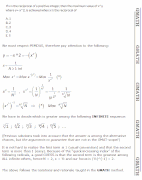Source: Manhattan GMAT
If x is the reciprocal of a positive integer, then the maximum value of x^y, where y=-x^2, is achieved when x is the reciprocal of
A. 1
B. 2
C. 3
D. 4
E. 5
The OA is B.
If x is the reciprocal of a positive integer, then the
This topic has expert replies
-
BTGmoderatorLU
- Moderator
- Posts: 2212
- Joined: Sun Oct 15, 2017 1:50 pm
- Followed by:6 members
Timer
00:00
Your Answer
A
B
C
D
E
Global Stats
GMAT/MBA Expert
- Scott@TargetTestPrep
- GMAT Instructor
- Posts: 7262
- Joined: Sat Apr 25, 2015 10:56 am
- Location: Los Angeles, CA
- Thanked: 43 times
- Followed by:29 members
BTGmoderatorLU wrote:Source: Manhattan GMAT
If x is the reciprocal of a positive integer, then the maximum value of x^y, where y=-x^2, is achieved when x is the reciprocal of
A. 1
B. 2
C. 3
D. 4
E. 5
Let a be the positive integer that x is reciprocal of, i.e., x = 1/a. We have x^y = x^(-x^2) = 1/(x^(x^2)). In terms of a, we have:
1/{(1/a)^[(1/a)^2]}
a^[1/a^2]
If a = 1, then a^[1/a^2] = 1.
If a = 2, then a^[1/a^2] = 2^(1/4).
If a = 3, then a^[1/a^2] = 3^(1/9).
If a = 4, then a^[1/a^2] = 4^(1/16).
If a = 5, then a^[1/a^2] = 5^(1/25).
We can eliminate a = 1, since when a is any of the other 4 values, a^[1/a^2] is greater than 1. Now, let's do a pairwise comparison between the other 4 choices.
2^(1/4) vs. 3^(1/9)
Let's raise both by 36th power:
[2^(1/4)]^36 = 2^9 = 512
[3^(1/9)]^36 = 3^4 = 81
We see that 2^(1/4) is greater. Let's compare it with 4^(1/16).
2^(1/4) vs. 4^(1/16)
Let's raise both by 16th power:
[2^(1/4)]^16 = 2^4 = 16
[4^(1/16)]^16 = 4^1 = 4
We see that 2^(1/4) is still greater. Let's compare it with 5^(1/25).
2^(1/4) vs. 5^(1/25)
Let's raise both by 100th power:
[2^(1/4)]^100 = 2^25 = (2^3)^8 * 2^1 = 8^8 * 2
[5^(1/25)]^100 = 5^4
We see that 2^(1/4) is still greater. Therefore, 2^(1/4) is the greatest.
Answer: B
Scott Woodbury-Stewart
Founder and CEO
[email protected]

See why Target Test Prep is rated 5 out of 5 stars on BEAT the GMAT. Read our reviews


GMAT/MBA Expert
- Jay@ManhattanReview
- GMAT Instructor
- Posts: 3008
- Joined: Mon Aug 22, 2016 6:19 am
- Location: Grand Central / New York
- Thanked: 470 times
- Followed by:34 members
We have to maximize that value of x^y = x^(-x^2) = 1 / x^(x^2)BTGmoderatorLU wrote:Source: Manhattan GMAT
If x is the reciprocal of a positive integer, then the maximum value of x^y, where y=-x^2, is achieved when x is the reciprocal of
A. 1
B. 2
C. 3
D. 4
E. 5
The OA is B.
Say the positive integer is a, thus, x = 1/a
1 / x^(x^2) = 1 / (1/a)^{(1/a)^2} = a^(1/a^2)
So, We have to maximize that value of a^(1/a^2)
Let's try with options:
A. a = 1: a^(1/a^2) = 1^(1/1^2) = 1
B. a = 2: a^(1/a^2) = 2^(1/2^2) = 2^(1/4)
C. a = 3: a^(1/a^2) = 3^(1/3^2) = 3^(1/9)
D. a = 4: a^(1/a^2) = 4^(1/4^2) = 4^(1/16)
E. a = 5: a^(1/a^2) = 5^(1/5^2) = 5^(1/25)
Option A cannot be the correct answer since the values of each of the other options is greater than 1.
For options B through E, for a^(1/a^2), the values of bases (a) increase, while the values of exponents (1/a^2) decrease, thus, it is not straightforward to choose the option that has the maximum value.
We see that for options B through E, for a^(1/a^2), the rate of increase of the bases (a) is relatively lesser than the rate of decrease of the exponents (1/a^2), thus, though because of the increase of values of bases, the values of a^(1/a^2) increase, their values decrease considerably due to the decrease in the values of exponents. Thus, as we move from option B, C, D, and E, the values decrease. Thus, the maximum possible value of a^(1/a^2) is at a = 2.
The correct answer: B
Hope this helps!
-Jay
_________________
Manhattan Review
Locations: Manhattan Review Madhapur | GMAT Prep Kukatpally | GRE Prep Jayanagar | Tarnaka GRE Coaching | and many more...
Schedule your free consultation with an experienced GMAT Prep Advisor! Click here.
- fskilnik@GMATH
- GMAT Instructor
- Posts: 1449
- Joined: Sat Oct 09, 2010 2:16 pm
- Thanked: 59 times
- Followed by:33 members
Fabio Skilnik :: GMATH method creator ( Math for the GMAT)
English-speakers :: https://www.gmath.net
Portuguese-speakers :: https://www.gmath.com.br
English-speakers :: https://www.gmath.net
Portuguese-speakers :: https://www.gmath.com.br




















